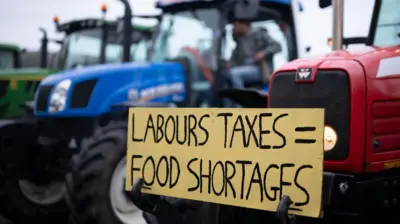We've updated our Privacy and Cookies Policy
We've made some important changes to our Privacy and Cookies Policy and we want you to know what this means for you and your data.
Autumn Statement: What is it?
Image source, Getty Images
- Author, Emily Young
- Role, 91ČČąŹ News
The Autumn Statement is the second of the two most important economic statements that the chancellor gives every year, the first being the Budget. This year's takes place on Wednesday, 3 December at about 12:30 GMT (after Prime Minister's Questions).
What's the point of it?
The chancellor updates MPs on the government's taxation and spending plans, based on the economic projections provided by the Office for Budget Responsibility (OBR) - a body set up in 2010 to provide independent economic forecasts.
The OBR publishes its estimates for the country's economic growth and the government's finances as soon as the chancellor finishes making his speech.
Autumn - it's December!
Well, yes. In the 80s and 90s the statements were usually in November, but since 2003 they have more often than not come in December. I suppose the best way to think about it is like the autumn term at school or university - it just comes at the end of it.
How is it different from the Budget?
Image source, Getty Images
Good question. Traditionally, the Autumn Statement has outlined economic projections and broad departmental spending allocations, while the Budget largely dealt with taxation plans. However, that line has been increasingly blurred and taxation plans are now also announced in the Autumn Statement.
One other difference is that during the Budget, chancellors are allowed to refresh themselves with alcoholic drinks - no other MPs can do this. Alas for the chancellor, no such tradition applies to the Autumn Statement.
The Autumn Statement has undergone various permutations. In the 90s, Ken Clarke moved the Budget to autumn and then had a Summer Statement. Under the last Labour government it was called the Pre-Budget Report.
Oh yes, the Pre-Budget Report - I vaguely remember that.
Labour introduced the term Pre-Budget Report to highlight the fact that it had become more about trailing taxation and spending plans for the Budget. Announcing them earlier gave more time for consultation and implementation before the end of the tax year. George Osborne changed the name back to the Autumn Statement in 2010.
When was the Autumn Statement first introduced?
Image source, Getty Images
In 1975 an act of Parliament made it a duty for the government to publish two economic updates a year. The first such forecast was made in 1976, by the then-Chancellor, Denis Healey. The first reference to an Autumn Statement , although it was also frequently referred to as the spending round.
So what is the chancellor going to say?
We won't know for sure until he gets up in front of Parliament at about 12:30 GMT (after Prime Minister's Questions) on Wednesday, 3 December (you can follow his speech live on the 91ČČąŹ website) but Mr Osborne has already indicated that he will detail measures to give three cities in the north of England - Leeds, Sheffield and Manchester - more "London-style" self-rule.
He has also promised a crackdown on tech companies that go to "extraordinary lengths" not to pay their tax.
And there will also be more details on the government's investment plans for the country's busiest roads, including a tunnel to go under Stonehenge with the aim of getting rid of the regular bottleneck on the A303.
So it starts at 12:30... when will it finish?
That's anyone's guess - and the subject of many an office sweepstake (or is that just business journalists?)
At the moment bookmakers William Hill have the shortest odds on it lasting less than 50 minutes (the suggestion being that any longer and the backbenchers might start nodding off). But digesting the contents of it will take days, if not weeks.
Top Stories
More to explore
Most read
Content is not available








